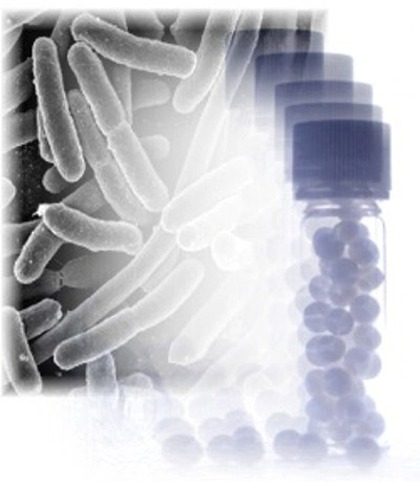Featured
Strong Biological Activity of Homeopathic Remedy on Arsenic-Poisoned E. Coli Shown in Study
It’s time for the naysayers to start looking beyond the ends of their collective noses and stop the collective chant against homeopathy and real science.
A new study shows that the effects of a homeopathic preparation of glucose on arsenic-poisoned E. coli bacteria are significant. Researchers focused on arsenic (in the form of arsenite) because it’s a common toxin, so virtually all animal life has the ability to detox it. They compared the effects of homeopathic Glucose 30C, in which it’s nearly impossible for any molecules of the original substance to be left, with normal controls and a “placebo” dose. The researchers were blinded during observation and scoring results.
Claims by homeopathy naysayers that homeopathy can’t work because there is no substance of the original material in the remedies are simply wrong. The issue is not whether we understand how it works, but only whether it works. As this study demonstrates,something in a homeopathic remedy acts on living organisms. There is simply no way to avoid that fact, other than by willfully ignoring the evidence.
The Study
The experiment was performed by Indian researchers from the Cytogenetics and Molecular Biology Laboratory of the Department of Zoology at the University of Kalyani in Kalyani, India.
The methodology was simple and straightforward. Samples of E. coli cultures were grown to their log phase (meaning their full growth level within the culture) for each variation on the arsenite application. They were:
- Control, no arsenite added
- Arsenite added at 1mmol/liter
- Arsenite added at 2 mmol/liter
Each measurement was done in nine culture samples. The E. coli bacteria were not disease-inducing variants.
Several measurements were taken at 45 minutes and at 90 minutes. The results were recorded and averaged, with variances (±) noted. The following measurements were done:
- Glucose uptake by spectrophotometric analysis
- Hexokinase assay by spectrophotometric analysis
- Glucokinase assay by spectrophotometric analysis
- Total ATP by luminometric study
- Membrane potential by spectrofluorimetric method
- Membran potential by flow-cytometry method
- RNA isolation, cDNA preparation and gene level expression study by reverse transcription-polymerase chain reaction
- Quantitative real-time reverse transcription-PCR
- Extracellular arsenic by atomic absorption spectroscope
- Intracellular arsenic by atomic absorption spectroscope
This review will cover only the first four and last two measurements taken. Those will suffice to demonstrate that significant effects were observed as a result of the application of Glucose 30C.
Glucose Uptake
E. coli’s glucose uptake is increased on exposure to arsenite, helping it to expel the toxin. The addition of arsenite severely cut Measured in micrograms per milliliter (µg/ml) of glucose left in solution after 45 and 90 minutes, the results are:
| Glucose Uptake (µg/ml per cell) | ||
| Application to E. coli | After 45 minutes (µg/ml) |
After 90 minutes (µg/ml) |
| Control | 4.17±0.07 | 0.53±0.04 |
| 1mmol/liter arsenite | 7.56±0.90¹ | 2.87±0.50¹¹ |
| 1mmol/liter arsenite + placebo | 7.47±1.00 | 2.90±0.59 |
| 1mmol/liter arsenite + Glucose 30C | 8.20±1.00 (8.5% inc. over ¹) |
3.12±0.40 (8.7% inc. over ¹¹) |
| 2mmol/liter arsenite | 8.21±0.90² | 3.10±0.25²² |
| 2mmol/liter arsenite + placebo | 8.12±1.00 | 2.98±0.50 |
| 2mmol/liter arsenite + Glucose 30C | 8.80±1.20 (7.2% inc. over ² |
3.45±0.50 (11.3% inc. over ²²) |
45 minutes after adding 1 mmol/liter arsenite and Glucose 30C to E. coli, the glucose uptake is 8.5% greater than what’s triggered by the arsenite alone. At 90 minutes, it’s 8.7% better. At 45 minutes in the 2mmol/liter concentration, the increase resulting from Glucose 30C is 7.2%, and at 90 minutes the glucose uptake improvement is 11.3%.
This alone demonstrates that a homeopathic remedy with no material substance left in it does have the ability to effect change in living organisms. But other tests in the study also demonstrate effects.
Hexokinase Activity
Hexokinase is an enzyme that facilitates phosphorylation to make glucose-6-phosphate (G6P). Phosphorylation reduces the resultant G6P’s ability to move or be transported outside the cell. Thus, reduction of hexokinase aids the cell’s ability to transport arsenic out of cell.
Hexokinase Activity (µmol/mg·min)
Application to E. coli After 45
minutes (µmol/mg·min) After 90
minutes (µmol/mg·min)
Control 0.058±0.006 0.045±0.004
1mmol/liter arsenite 0.023±0.003¹ 0.021±0.001¹¹
1mmol/liter arsenite + placebo 0.020±0.004 0.020±0.003
1mmol/liter arsenite + Glucose 30C 0.017±0.003
(2.6% dec. from ¹) 0.015±0.005(28.9% dec. from ¹¹)
2mmol/liter arsenite 0.020±0.004² 0.017±0.002²²
2mmol/liter arsenite + placebo 0.020±0.002 0.016±0.002
2mmol/liter arsenite + Glucose 30C 0.013±0.002
(35% dec. from ²) 0.013±0.003
(23% dec. from ²²)
The hexokinase activity results show up in rate of decline. At 1 mmol/liter of concentration arsenite, adding Glucose 30C decreases hexokinase activity by 2.6% at 45 minutes, and at 90 minutes, it’s decreased by 28.9%.
The result is even more dramatic when 2 mmol/liter of arsenite is added. The natural drop in hexokinase activity is reduced by 35% at 45 minutes and 23% at 90 minutes when Glucose 30C is added.
Glucokinase Activity
Like hexokinase, glucokinase is an enzyme that facilitates glucose phosphorylation to make a form of G6P. Its reduction in the cell aids in the ability to detox arsenic. Therefore, lower levels of glucokinase benefit the detox process.
Glukinase Activity (µmol/mg·min)
Application to E. coli After 45
minutes (µmol/mg·min) After 90
minutes (µmol/mg·min)
Control 0.068±0.005 0.042±0.005
1mmol/liter arsenite 0.009±0.002¹ 0.007±0.001¹¹
1mmol/liter arsenite + placebo 0.009±0.002 0.007±0.001
1mmol/liter arsenite + Glucose 30C 0.008±0.002
(11.1% dec. from ¹) 0.003±0.001
(57% dec. from ¹¹)
2mmol/liter arsenite 0.009±0.002² 0.006±0.001²²
2mmol/liter arsenite + placebo 0.009±0.002 0.006±0.001
2mmol/liter arsenite + Glucose 30C 0.007±0.001
(22.2% dec. from ²) 0.003±0.002
(50% dec. from ²²)
The decrease in glucokinase activity is even more significant than that of hexokinase activity. At 90 minutes into the 1mmol/liter arsenite concentration, the glucokiinase activity is cut by 57% over the natural process when Glucose 30C is added, and at 2mmol/liter, the rate is cut by 50%.
Intracellular ATP
ATP is the chemical energy of a cell. Arsenite take a big toll on a cell’s energy, so a desirable result is an increase in ATP.
Intracellular ATP (µmol/mg·min)
Application to E. coli After 45
minutes (µmol/liter) After 90
minutes (µmol/liter)
Control 4.750±0.113 1.930±0.111
1mmol/liter arsenite 0.834±0.111¹ 0.579±0.115¹¹
1mmol/liter arsenite + placebo 0.834±0.115 0.575±0.113
1mmol/liter arsenite + Glucose 30C 1.202±0.115
(44% inc. over ¹) 0.779±0.112
(35% inc. over ¹¹)
2mmol/liter arsenite 0.819±0.115² 0.559±0.113²²
2mmol/liter arsenite + placebo 0.817±0.118 0.584±0.119
2mmol/liter arsenite + Glucose 30C 1.776±0.11
(117% inc. over ²) 0.834±0.111
(49% inc. over ²²)
The increase in ATP with the addition of Glucose 30C is highly significant. At 1 mmol/liter, it is 44% higher after the first 45 minutes, and 35% higher after 90 minutes. At 2mmol/liter, it’s 117% higher after 45 minutes and 49% higher after 90 minutes.
Extracellular Arsenic
Extracellular Arsenic (µg/liter)
Application to E. coli After 45
minutes (µg/liter) After 90
minutes (µg/liter)
Control 196.67±17.0 227.332±22.0
1mmol/liter arsenite 295.79±23.0¹ 321.24±26.0¹¹
1mmol/liter arsenite + placebo 289.93±22.0 314.71±28.0
1mmol/liter arsenite + Glucose 30C 337.50±22.0
(14.1% inc. over ¹) 356.80±27.5
(11.2% inc. over ¹¹)
2mmol/liter arsenite 368.18±26.0² 419.05±32.0²²
2mmol/liter arsenite + placebo 365.92±25.0 413.83±30.5
2mmol/liter arsenite + Glucose 30C 398.00±24.6
(8.1% inc. over ²) 445.80±31.8
(6.4% inc. over ²²)
Obvously, the more arsenite that ends up outside the E. coli cells, the better. At the 1mmol/liter concentration, the samples with Glucose 30C added held 14.1% more extracellular arsenite at 45 minutes than the controls did, and after 90 minutes, they held 11.2% more. At the 2mmol/liter concentration, the Glucose 30C samples held 8.1% more extracellular arsenite at 45 minutes, and 6.4% more after 90 minutes.
Intracellular Arsenic
Intracellular Arsenic (µg/liter)
Application to E. coli After 45
minutes (µg/liter) After 90
minutes (µg/liter)
Control 1.54±0.12 0.35±0.02
1mmol/liter arsenite 19.24±1.50¹ 2.79±0.80¹¹
1mmol/liter arsenite + placebo 19.62±1.80 2.81±0.70
1mmol/liter arsenite + Glucose 30C 16.90±1.80
(12.2% dec. from ¹) 2.54±0.90
(9.0% dec. from ¹¹)
2mmol/liter arsenite 22.04±2.34² 3.44±1.10²²
2mmol/liter arsenite + placebo 21.82±2.00 3.50±0.85
2mmol/liter arsenite + Glucose 30C 20.40±2.12
(7.4% dec. from ²) 2.80±1.20
(18.5% dec. from ²²)
Intracellular arsenite measurements were significantly decreased by the use of Glucose 30C. At the 1mmo/liter concentration, the decrease at 45 minutes was 12.2% lower, and at 90 minutes it was 9.0% lower. At the 2mmo/liter concentration, the 45 minute decrease was 7.4% lower, and it was 18.6% lower at 90 minutes.
Implications of the Study
Avogadro’s limit is the point at which a dilution is so attenuated that not a single molecule of the original substance is likely to exist in any sample. This study demonstrates that a homeopathic remedy potentized beyond Avogadro’s limit can have definitive measurable effects on a living creature. What exerts that effect is, as yet, unknown.
It is the role of science to attempt to find the reasons behind our observations. It’s not science to claim that something observed cannot happen because our current state of knowledge is inadequate to explain it. To say that something cannot exist because we don’t know how it works is equivalent to saying that the sun didn’t shine until we had some understanding of nuclear physics.
This is not the first experiment to document the effects of homeopathic remedies on living tissues. Surely, it’s time for the naysayers to start looking beyond the ends of their collective noses and start searching for how homeopathy works, rather than doing the equivalent of a child’s squeezing eyes shut, sticking fingers in ears, and chanting, “I can’t hear you, go away! I can’t hear you, go away!”
Tagged E. coli, homeopathic glucose, homeopathic remedy, Homeopathy





















Pingback: carmen electrica
Pingback: url submit
Pingback: free domain name
Pingback: affiliate programs
Pingback: virtuemart templates
Pingback: seo ranking
Pingback: laptops under 400
Pingback: affiliate marketing blog
Pingback: karen millen outlet online
Pingback: seo optimization services
Pingback: karen millen collection
Pingback: Click on this link